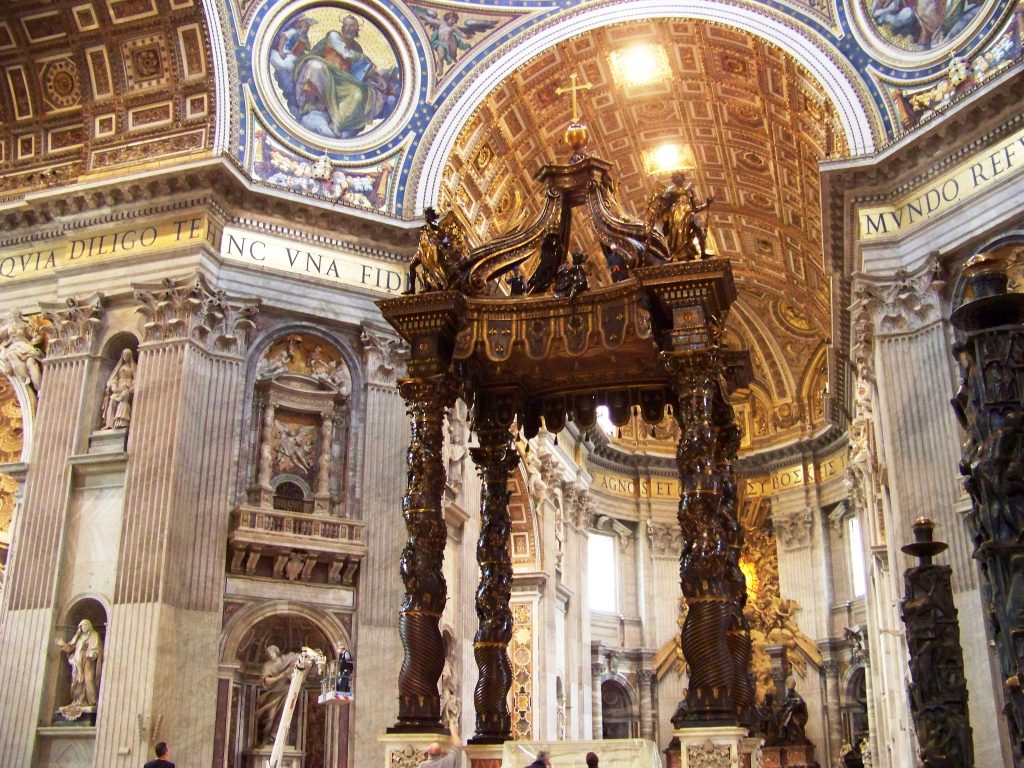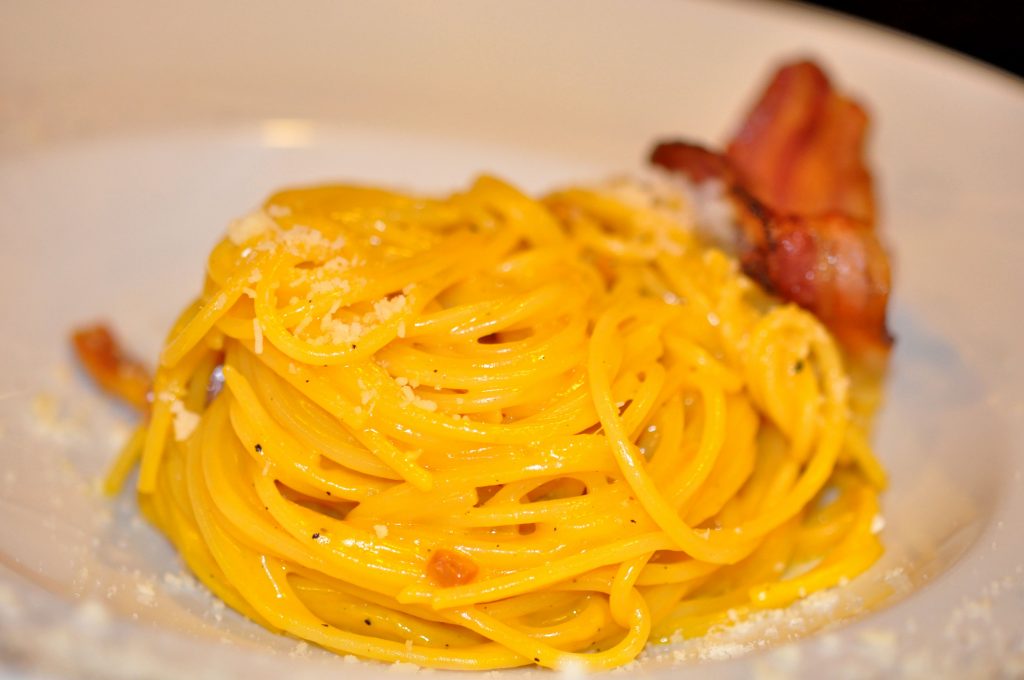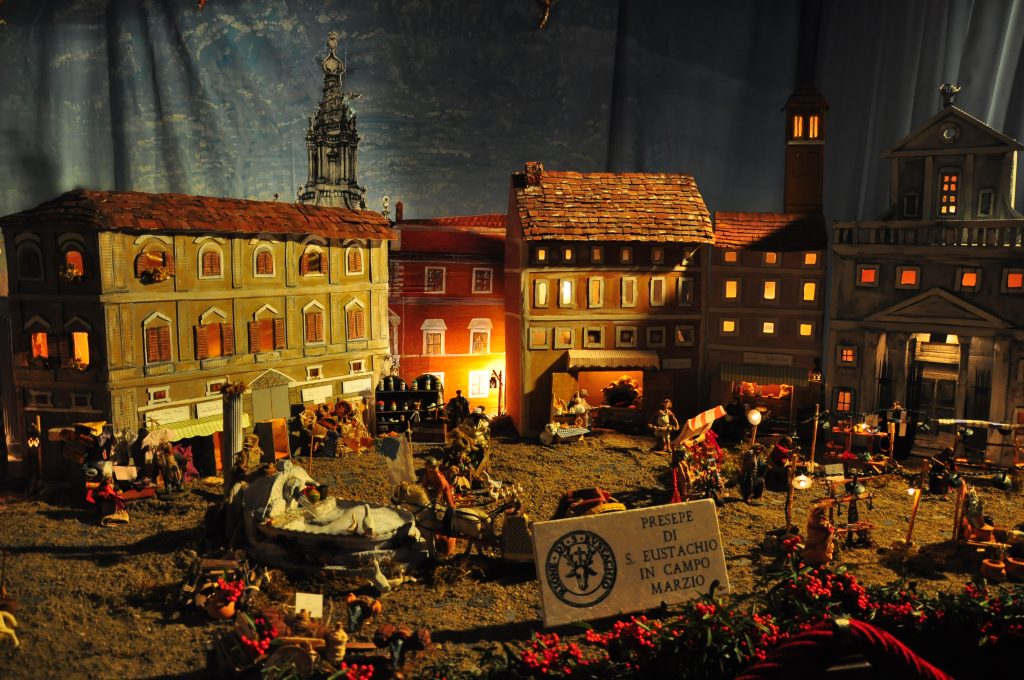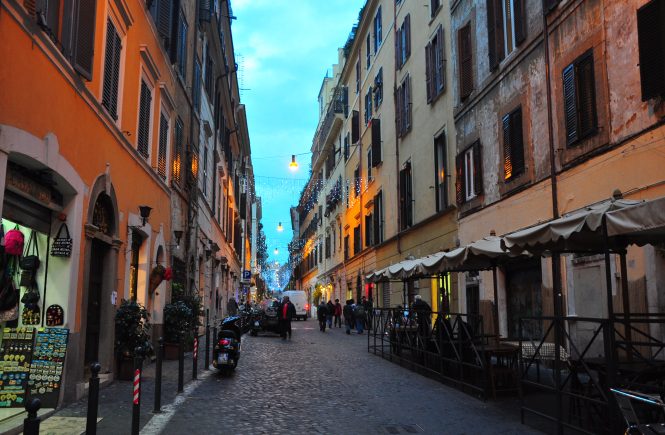Want to know the best ways to explore Vatican City and get to know the Pope — beyond St. Peter’s Basilica? Check out my roundup of Vatican secrets in the August/September issue of National Geographic Traveler (…it’s the cover story!), from where to shop for papal socks to seeing the “other” Sistine Chapel. Not in the US? You can also check out a version of the piece online here.
On Fridays Through Fall, See the Vatican Under the Stars
If you want to avoid the usual Sistine Chapel crowds, here's one way to do it: Go to the Vatican at night.
For the third year in a row, the Vatican museums are having their "extraordinary opening" from 7pm-11pm. Last year, more than 30,000 people took advantage. And whether your day is completely booked or you'd simply like to see the Sistine Chapel and Laocoön in a bit of a more serene atmosphere, now's your chance.
The museums will be open on Friday nights from now until July 15, and then again from Sep. 2 until Oct. 28. Last admission is at 9:30pm.
The areas open in the museums are the Egyptian museum, Pio-Clementine, Galleries of Tapestries, Candelabra, and Maps, Raphael Rooms, Borgia Apartment, Collection of Modern Religious Art, and, of course, the Sistine Chapel. (There's no guarantee, and it's in fact unlikely, that other areas, like the Pinacoteca, will be open).
Tickets must be booked in advance, so the full-price ticket is €19 (includes the €4 reservation fee), or €12 reduced (students, bring your I.D.s!). Click here to book.
Celebrate Easter… with the Pope!
Lots of Romans head out of the city this weekend, going home for Easter. One Rome resident who'll be around Easter weekend, though, is the Pope — and if you want to catch a glimpse of him, you have plenty of opportunities!
Today, the big Good Friday event is the Way of the Cross ("Via Crucis"). Be at the Colosseum at 9:15pm to see the Pope (and thousands of people); be aware that nearby streets will be blocked to traffic and that the Colosseo metro stop will be closed after 6:30pm. After all, just look at these crowds…
Tomorrow, the Pope will preside over the Easter Vigil at St. Peter's Basilica, starting at 9pm.
On Easter Sunday, the Pope will celebrate Mass in St. Peter's Square at 10:15am, followed by the "Urbi et Orbi" blessing from the central loggia of St. Peter's at noon.
And, just for fun, here are a couple more photos from last year's Via Crucis at the Colosseum.
Buona Pasqua a tutti!
Coming to the Beatification in Rome? Here’s What to Expect

Whether you’re one of the brave souls coming to Rome for the beatification ceremony of Pope John Paul II on May 1, or someone who will just happen to be here anyway, be warned: You’re not the only one. It’s been estimated that 2 to 3 million pilgrims will alight on the city — doubling Rome’s population.
Obviously, we won’t know if that happens till it happens. But it’s probably smart to plan ahead. So anything you can book far in advance, whether hotel or Vatican or walking tour or restaurant, do. And bring your walking shoes: If this many people will really be here, that means cabs will be full and the bus and metro systems, already full during rush hour, will be packed all day along. But even if you’re all booked, remember that even the best-laid plans can go awry. That’s true on the best of days in Rome. It’ll be even more true now.
One thing that you should be able to count on, though, is the schedule of events for the beatification ceremony itself. The detailed schedule was just announced a couple of days ago. Here it is:
Saturday, April 30
8pm. Prayer vigil, Circus Maximus. Speakers will include Pope John Paull II’s closest aide, Cardinal Stanislaw Dziwisz, and his spokesman Joaquin Navarro-Valls; Pope Benedict XVI will recite the final oration and bless the people.
Sunday, May 1
9am. St. Peter’s Square. Hour of preparation, when the faithful pray the Chaplet of Divine Mercy together.
10am. The liturgy of the beatification, followed by a mass. At the end, a tapestry of Pope John Paul II will be unveiled. After, the Pope and cardinals will pray before John Paul’s body in St. Peter’s Basilica.
Evening. John Paul II’s remains will continue to be in front of the basilica’s main altar (known as the “Altar of Confession”), and pilgrims are welcome to venerate there.
Monday, May 2
10:30am. St. Peter’s Square. A thanksgiving mass will celebrate John Paul II, with music by the Choir of the Diocese of Rome, Choir of Warsaw and the Wadowice Symphony Orchestra of Poland.
In San Lorenzo, One of Rome’s Best Churches
Today, the neighborhood of San Lorenzo is known for its students, grungy atmosphere, graffiti… and as a place you might not exactly want to wander around alone late at night.
But it should be known for something else, too: the magnificent church that gave the quarter its name.
First off, San Lorenzo fuori le Mura (or "St. Lawrence outside the Walls," because it is — justbarely — outside the city center) is ancient. Literally. Better yet, more of the ancient design has survived here than in Rome's (admittedly many) other ancient churches. Emperor Constantine, the first Christian emperor of Rome, first built an oratory here in the 4th century; the church itself came in the 5th century and was reconstructed by the Byzantines in the 6th.
And there are more than traces of the 5th- and 6th-century structures today. Walk up to the very front of the church and around the altar, and you're exploring the same aisles and chancel that the ancients built (below). Not only that, but the mosaic above you — restored in the Renaissance to the brilliant colors you see today — dates back to the Byzantines, too. 
Okay, so the church is ancient, and it's beautiful. Yeah, yeah. What else?
Well, it's built on the spot where St. Lawrence himself is buried. One of Rome's most important saints, Lawrence met his fate during Valerian's persection of Christians in 258 A.D., and — the story has it — was grilled to death. (The Vatican has a sense of humor about the whole thing: Today, he's the patron saint of cooks and chefs).
Lawrence was buried in Christian catacombs here, and when Constantine became emperor, he built a shrine and funerary hall at Lawrence's tomb. That's all directly under the church's altar today. And if you peek through one of the grates under the altar, and bring a flashlight (or a flash camera!), you can see some of the ancient tunnels that, presumably, lead down into those catacombs. 
If that doesn't do it for you, make sure you also check out the mysterious marble slab behind the altar: According to tradition, this is where Lawrence's body was laid after he was grilled… and it left a stain that would never go away.
Not a big fan of St. Lawrence? Hey, it's okay. The church also has the remains of the martyrs St. Stephen and St. Justin, also beneath the altar. And if none of these ancient folks do it for you, then try the gloriously-decorated Chapel of Pope Pius IX, where the longest-reigning pope in history — as well as the pope who convened the First Vatican Council and decreed the dogma of the immaculate conception of Mary — is interred. The pope, who died in 1878, has been kept visible for the faithful today, with just a silver mask covering his face.
All this, of course, is leaving lots of things out. Like the gorgeous 13th-century episcopal throne and marble screen, inlaid with precious porphyry and granite. Or the 13th-century frescoes, still in good condition, on the exterior of the church as you enter. Or the lovely 12th-century cloister, complete with fragments of ancient inscriptions and sarcophagi… and with the remnant of an all-too-modern bomb, courtesy of the Allies, that hit the cloister in World War II.
I could go on. Instead, I'll just leave you with one last gem: a 2nd-century sarcophagus depicting a pagan marriage feast. (Today, incongruously, it holds the 13th-century remains of Cardinal Guglielmo Fieschi). 
The church is open daily from 7:30am-12:30pm, 3:30pm-7pm, and on Sundays from 7.30am-12.30pm and 4pm-8pm. It's located at Piazzale del Verano, 3, in the heart of San Lorenzo — a 20-minute walk from the Termini train station, or a 10-minute walk from the Policlinico metro stop on line B. Click here for a map.
You might also like:
What Is Open on Christmas in Rome? (Updated for 2019)
If you’ve booked your trip to Rome over Christmas, a couple of things normally happen. First, there’s elation. And then there’s an, “Oh no. What’s open on Christmas in Rome? Is anything open on Christmas in Rome?”
There’s reason to wonder. Many Romans do leave the city for their family homes over the holidays. Even so, there are still plenty of people left in this city of 3 million. Here’s what is open on Christmas in Rome… and what won’t be. (New Year’s, too). (For more tips and tricks, don’t miss my ultimate guide to Christmas in Rome!).
Will sites and museums be open during Christmas in Rome?
While some museums and sites will remain open even on Christmas Day and New Year’s, most of the biggies will be shut. The forum, Colosseum and Palatine will be closed Dec. 25 and Jan. 1, for example, but open every other day as usual, including Dec. 24.
The Vatican’s a tougher one: The Vatican museums and Sistine Chapel are closed on Dec. 8, Dec. 25, Dec. 26, and Jan. 1. They’re also closed every Sunday in December and January, as usual, except for the last Sunday of each month, when they are open and free.

Check with other sites individually. Here’s where you can find (in English) the hours for all of Rome’s major museums and archaeological sights. Outdoor sites like Piazza Navona and the Trevi Fountain, along with churches, also will be open.
Will the bus and metro be running over Christmas in Rome?
Yes. Often, the city even has an expanded service on Christmas Eve until the early afternoon. Service tends to end at about 9pm that night, though, and cabs are in very short supply, so if you need to be somewhere, give yourself lots of time to get there. On Christmas Eve, walking will probably be your best bet, so dress warmly!
Will restaurants be open on Christmas and New Year’s?
Most restaurants will be open every day except for Dec. 24, Dec. 25, and Jan. 1. Some others might close on Dec. 8, Dec. 31 and Jan. 6.
But many places will also be open on even those holidays themselves, including both classic Italian favorites and the kosher restaurants in the Ghetto. Just remember to book in advance.

Katie Parla has a nice little list of good Rome restaurants that are open over the holidays, including Metamorfosi, Romeo and Roscioli.
I want to go shopping over the holidays. Can I?
Throughout December and January, yes. However, most shops will close early on Christmas Eve and will not be open on Christmas Day. Other days some might be closed or have shorter hours include Dec. 8, Dec. 26, and Jan. 1.
- Finding this helpful? Then you’ll love The Revealed Rome Handbook: Tips and Tricks for Exploring the Eternal City, available for purchase on Amazon or through my site here and now updated for 2020!
If you want the saldi, you’ll have to wait — usually, these after-Christmas sales kick off throughout Lazio on the third Saturday of January.
And what about churches?
Ah, churches! They will, of course, be open on Christmas; many will offer mass at the same time they’d usually have their Sunday service. If you’re interested in attending mass, check with the church in advance. Otherwise, you’re fine to visit most churches as usual, being, of course, particularly respectful and refraining from taking flash photographs if a service is going on. And don’t forget to check out the church’s presepio (Nativity scene) — a particularly Italian handicraft (see below) that is only on display this time of year.

Also: Rome’s best Christmas markets, and 11 etiquette mistakes not to make eating in Italy.
Want more great tips and tricks for Rome? Check out The Revealed Rome Handbook: Tips and Tricks for Exploring the Eternal City, available for purchase on Amazon, below, or through my site here!
Eight Tips When Planning a Trip to Rome
Yes, your passport’s important. But that’s not what I mean. As much as many people seem to plan their trips to Rome down to the detail, there are some mistakes that can be easy to make… from using TripAdvisor for restaurants to coming during ferragosto. Below, eight items to keep in mind while planning a trip to Rome.
1. Bring your student ID. If you’re a university student, bring your I.D. card with you. It’s true that this gets you fewer discounts than it does in more student-friendly countries like, say, Greece, but it does get you a discount at the Vatican (€8 instead of €15) and can come in handy elsewhere, too. If you’re an E.U. citizen, also make sure to bring an I.D. with you whenever you’re sightseeing: You lucky Europeans get discounts at almost all of Rome’s sites, including the Colosseum, forum, and Borghese Gallery.
2. Don’t come in July or August Think about what time of year you’re coming. Yes, little Johnny gets the summer off from school. But so do everybody else’s kids, so this is when the hotels are full (and pricey), the Colosseum’s packed, and you have to stand on tiptoes to get a look at the Vatican’s Laocoön. Not to mention that it’s hot, sweaty, and in August, Romans celebrate ferragosto — meaning that the city’s best restaurants and family-run shops are closed. (For proof, see photo above). Scheduling limitations are understandable. But if there’s any way to sweep away to Rome in June, or better yet, spring break, fall, or Christmas, you’ll have a much more relaxing, rewarding experience. Little Johnny will thank you.
3. Do your restaurant research… Understandably, a lot of people come to Rome and think, “All these restaurants serve Italian food. They MUST all be good!” Sadly, that’s not the case. You would wind up eating in a tourist trap if you showed up at Times Square hungry and confused (I know I have…), and you will wind up having the same experience in Rome. Not might. Will. It’s a tourism-based city, and lots of restaurants take advantage of that, shoveling their customers terrible, microwaved food along with a gut-wrenching bill.
So if you’re spending any amount of time thinking about what museums and sites you want to see in Rome (and who doesn’t?), then do yourself a favor: Use some of that time to think about where you’ll eat, too. You’ll be spending at least two hours a day dining, three or four if you’re doing it the Italian way. You don’t want to feel like those hours, or euros, are wasted.
4. …but don’t do your restaurant research on TripAdvisor. Yes, TripAdvisor is good for some things. It is not good for restaurant recommendations, at least here in Rome. It’s too easy to play the system — aggressively asking clients to post 5-star reviews, having cousins and siblings put up fake reviews, etc. I’m not casting any aspersions on the restaurants that are listed as Rome’s “best” on TripAdvisor. But. Suffice it to say that I’ve never heard of most of the TripAdvisor top-15 (Taverna dei Fori Imperiali, a local favorite, and Babbo’s, which is pretty good for the value, aside), among anyone claiming to be a “foodie” or even “very enthusiastic eater.” And those restaurants have never, ever come up as recommendations to me from any Roman or expat friends in all the times I’ve asked.
But the bad news continues. Also be wary of guidebooks, since as with all restaurant scenes, things change quickly here in Rome, and guidebook-info is often at least a year behind. (Not to mention that as soon as a restaurant winds up in a guidebook, it often starts resting on its laurels). For proof, just check out my post on Ristorante Montevecchio. In 2007, it had a glowing review from NPR. But three years is a long, long time in the dining world.
 So what do you do? Well, research elsewhere — preferably in recent newspaper articles like, okay, mine, and on good Rome-food websites like Katie Parla’s www.parlafood.com. I’ll also be adding more and more restaurants to the “Food and Drink” part of this site, so stay tuned.
So what do you do? Well, research elsewhere — preferably in recent newspaper articles like, okay, mine, and on good Rome-food websites like Katie Parla’s www.parlafood.com. I’ll also be adding more and more restaurants to the “Food and Drink” part of this site, so stay tuned.
5. Think ahead of time about taking a tour. Because if you’re interested in the concept at all, what will happen is this: You’ll get to the Colosseum. You’ll see the line. Some nice-looking 20-something holding a clipboard will stop you and say “Hey, do you speak English? Do you want to skip this twenty-three-hour line?” And before you know it, you’ll be hustled into a tour that, well, might get mixed reviews, to put it nicely.
Instead, do your research in advance and think about what you might want to take a tour of. (The Vatican can overwhelm visitors, and those companies worth their salt arrange for you to skip the line; the Forum can seem like a pile of rubble without a knowledgeable guide; an evening city walk can help you get your bearings). Then book it. Done. You don’t have to think about it again — nor do you have to get swept into a group of 50 with a barely-English-speaking guide, all because you didn’t book a well-researched company in advance.
6. If making a strict itinerary, know your closing dates. I never fail to be saddened — and surprised — by the number of visitors who come to the Vatican Vatican museums on Sunday, expecting to waltz right in. Why do these downtrodden hordes surprise me? Because the Vatican museums (including the Sistine Chapel and Raphael rooms, of course) are always closed on Sunday. (Except for the last Sunday of the month, when it’s free, but that means the line snakes for miles and miles, so….).
If you’re planning your sites day by day, make sure you know what will be open when. If you can’t find out opening dates for a museum/restaurant/site through a quick search online, give them a call on Skype. Also, remember that if you want to go to the Borghese Gallery (and you should! It’s lovely!), you must reserve in advance.
7. Don’t get a RomaPass. Necessarily. A lot of visitors do this ahead of time because it seems like a great idea: Once you activate it, your first two entries to sites are free, the rest are discounted, and you get free public transport, for three days. Sounds pretty great, right?
Before you spring for it, though, consider which sites you’ll be going to first — and if “skipping the line” is worth it. (The only RomaPass site that tends to have a long line is the Colosseum). A RomaPass costs €25. Let’s say you’re coming to Rome and you’re doing a Colosseum tour with a company that lets you cut the line. So instead, you immediately do the Capitoline museums (€7.50 saved) and the Palazzo Barberini (€5 saved), neither of which have lines that I’ve ever seen. In the next three days, you would have to take the bus or metro six times and hit up three more sites that charge you entry for the card to even pay for itself. (Are you even going to three more sites that charge you entry? Most top spots, including the Pantheon, Spanish Steps, Trevi Fountain, St. Peter’s Basilica, and other churches, don’t have an entry fee. Plus, the RomaPass does not include the Vatican museums, a €15 entry).
You also don’t have to buy a RomaPass in advance: If you decide you want to buy one once you get here, you can purchase it from any of the ticket desks of the participating sites or from ticket desks at some metro stops, including Termini, Spagna and Ottaviano.
For a RomaPass FAQ, click here; for a list of the museums it includes and their respective discounts, click here.
8. Forget the traveler’s cheques. Or, at least, don’t go too crazy: They’re nice insurance, but can be way more of a hassle than they’re worth. Bringing a big wad of cash and expecting to change it when you get here is a bad idea, too, only because any of the money-exchange places you find will give you a “you-must-be-kidding” (and not in a good way) kind of rate.
Easier: Bring a couple of ATM cards and use them when you get here. (At least one will work. Really.) For bigger purchases, use a credit card, like Visa’s CapitalOne, that doesn’t bang you with a surcharge for international fees. Both options will give you the “High Street” exchange rate, not the rate that some guy with a storefront and some pretty currency symbols came up with.
Just remember two things. First: Credit cards are accepted far less often in Italy than they are in other countries, including the U.S. and U.K., so you should always have cash on hand. Second: To be on the safe side, make sure you call your bank and credit card companies in advance to inform them that you are going abroad, so charges that they see won’t be the nefarious workings of some Roman scam artist.
If you liked this post, you’ll love The Revealed Rome Handbook: Tips and Tricks for Exploring the Eternal City, available for purchase on Amazon or through my site here! I’m also free for one-on-one consulting sessions to help plan your Italy trip.
Walks of Italy Launches a Website, and More Tours

For the past eight years, Jason Spiehler has been a top name in the world of Rome walking tours, written up by both Rick Steves and the New York Times. Now, he’s started a company that focuses on offering tours by well-informed, passionate guides of Italy’s top sites. In Rome, that includes not just the Colosseum and St. Peter’s Basilica, but gems off the beaten path — like tours of the Galleria Borghese, the catacombs, and the city’s finest small churches.
(Full disclosure: I work for this company. But hey, I think that means I know the quality of our guides and the work that’s put in pretty well, too!).
The company just launched a website, www.walksofitaly.com, giving full information about all of the tours offered. So far, they cover Rome, Florence, and Pompeii. One top seller is the “Pristine Sistine” tour, which takes visitors into the Sistine Chapel first thing in the morning, before the crowds arrive. Another neat feature: All of the private tours give you the option of having “add-ons,” like another half-hour on the Palatine Hill or in the Imperial Forums. Convinced your tour’s the right one? You can book immediately online. Still have questions? You can shoot the tour coordinator, Linda, an email at info@walksofitaly.com, call, or even Skype.
Okay, enough plugging for one day. But seriously. Check out the website. I know I’m biased, but I still think it looks pretty good.









